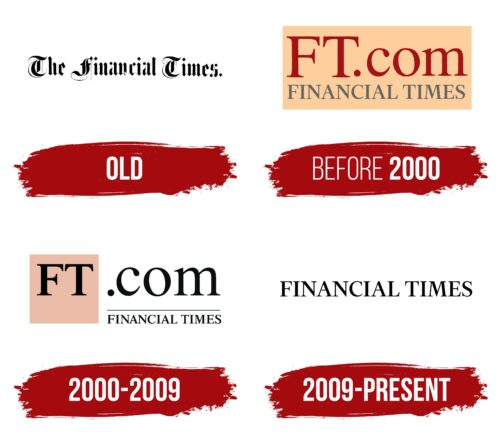The Financial Times logo is full of confidence and aristocratic elegance. The emblem shows: other publications look up to the newspaper, and the accuracy and reliability of its data are beyond doubt. News and indices are complemented by a talented presentation of material.
Financial Times: Brand overview
| Founded: | 9 January 1888 |
| Founder: | James Sheridan |
| Headquarters: | London, England |
| Website: | ft.com |
Financial Times is an English broadsheet daily newspaper for business people in English and Chinese (FT Chinese). It covers economics, finance, business, and major world and local news. It is issued in a circulation of 129 thousand copies and in web format. The website accumulates over 74 million views per month. The headquarters is located in London. The Japanese corporation Nikkei has owned the newspaper since 2015.
Meaning and History
The company’s logo is word-based. However, using abbreviations, points, and different sizes, makes the sign original. Over its 140-year history, the emblem has changed several times. Interestingly, the change of owners did not affect the publication’s visual identity. Neither Pearson, who bought the newspaper in 1957 nor Nikkei made adjustments to the media style. Rebrandings always relied on logic and were driven by the need to promote the newspaper. FT even chose its emblem with the reader in mind to provide the freshest and most truthful information about itself. Each sign is a way to interact with subscribers—an attempt to draw their attention to a segment in need of promotion.
What is Financial Times?
It is a major daily English-language publication from which you can learn the main news and information important for business. It is the founder and creator of the world’s largest companies ranking FT500. Publishes financial indices FTSE. More than 1 million readers worldwide visit the newspaper’s website daily.
Old
The first logo consists of the title executed in an old English font, which is quite consistent with the periodicals of the late 19th century. Interestingly, this is not the newspaper’s first name. The publication was initially registered as the London Financial Guide. The name was changed within a month.
A unique feature of the emblem is the diamond-shaped point at the end of the inscription, which contradicts publishing punctuation rules. This technique is an attempt to show that FT provides exhaustive information on all financial matters and is the only such source. The scope and breadth of the media indeed exceeded its four main competitors, the last of which (Financial News) the newspaper absorbed in 1945.
before 2000
At the end of the 20th century, the publication’s logo was an orange rectangle containing a red inscription: FT.com below that were the words Financial Times in grey capital letters.
This composition conveyed the most important information about the publication.
The orange rectangle was chosen as a symbol of the newspaper. The color is a distinctive feature of the media. Articles are printed on light reddish paper, which makes the media easily recognizable among other periodicals. Originally, this was an attempt to stand out and differentiate from competitors. Plus, the unbleached paper was cheaper. Nowadays, to retain this “twist,” there is an extra charge for special dyeing of the canvas.
FT.com is the address of the newspaper’s website. It was registered in 1994 and is now a more popular source of information compared to the print version. Visits to the web resource are 23 times higher than circulation.
In the logo, it is given a central place and the largest letters. In the 90s, this was an advertisement for an alternative subscription option, as the website had just been launched when the logo was created.
Interestingly, a light orange background is also used for the newspaper on the internet, maintaining the chosen style.
The grey letters of the Financial Times represent the publication as an accurate financial directory to which people turn for current information. The color signifies continuous diligent work. The uppercase lettering emphasizes leadership in its niche.
2000 – 2009
In 2000, the logo became even more original. In the first half of the sign are the large capital letters FT. Then, the emblem is divided into two levels. On the top level is “.com,” and on the lower level is “Financial Times.” The word image is like a puzzle, which reads: “Financial Times has two forms of release: a site on the com domain and a print version.”
The abbreviation FT rests on a pinkish vertical rectangle, which further reminds one of the newspapers. The domain name uses the largest possible letters, under which the entire inscription “Financial Times” fits in length. The sizes demonstrate the proportion of subscribers’ distribution between the print and web versions.
The two levels subtly hint at the newspaper’s two main sections: news and finance.
Overall, the construction of the emblem is based on logic and mathematics, which best represents a financial publication.
2009 – today
By 2009, the number of print version buyers had significantly decreased. Therefore, the emblem no longer emphasized the website. It was already well-known. The sign uses the full name of the media, the same for both versions.
The elegant uniform glyphs with serifs and elements of varying thickness demonstrate the newspaper’s age and experience. It combines useful information and journalistic talent. The elegant inscription embodies the periodical’s association with qualities-media, aimed at highly educated, literate, and stylish readers.
Font and Colors
Black color is leading in the modern logo. The shade speaks of precision, rigor, and business information. The saturated color presents the newspaper as a leader among England’s financial publications. The palette also reflects the reliability and continuity of the media, which has been published daily without interruption since 1888.
The font is reminiscent of Civita Medium, with sharp serifs and letter endings as if chiseled. The thin elements speak of the ability to correctly place accents and highlight the subtlest nuances of the complex financial market.
Financial Times color codes
| Black | Hex color: | #000000 |
|---|---|---|
| RGB: | 0 0 0 | |
| CMYK: | 0 0 0 100 | |
| Pantone: | PMS Process Black C |








